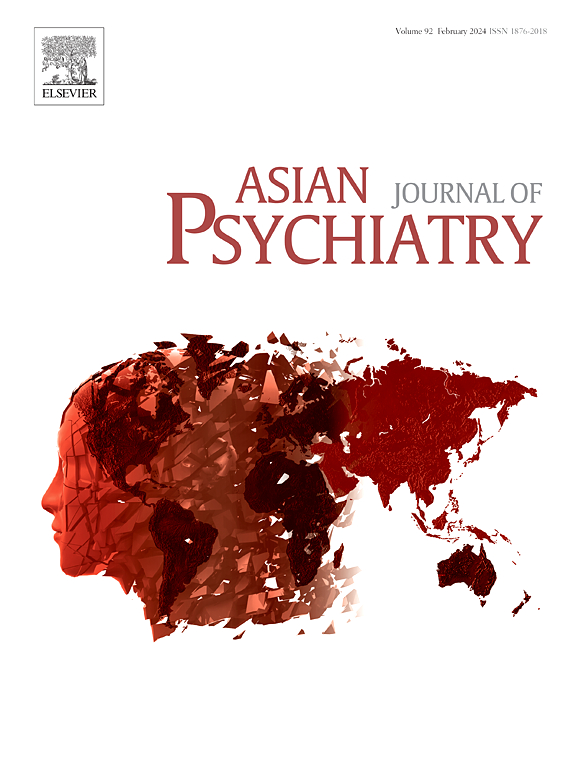Boosting and maintaining the response to transcranial direct current stimulation (tDCS) in schizophrenia with persistent hallucinations: A retrospective exploratory study from a naturalistic clinical cohort
IF 3.8
4区 医学
Q1 PSYCHIATRY
引用次数: 0
Abstract
Background
Transcranial direct current stimulation (tDCS) may help to alleviate persistent auditory hallucinations (AH) in schizophrenia, though its effects vary. This study examines the effectiveness, replicability and tolerance of booster and maintenance tDCS courses administered to patients with schizophrenia in a naturalistic clinical setting after an initial tDCS course.
Methods
Thirty-three patients received booster course(s) (after symptom relapse) and/or maintenance courses (to prevent relapse) following an initial course of 2–15 days. Linear mixed-effect (LME) model and intra-class correlation (ICC) evaluated the differences and consistency of percentage improvement in AH across the initial and booster courses. The duration between the initial and the first booster course served as a proxy for time to relapse, with its relationship to clinical and demographic measures analyzed using Pearson’s correlation.
Results
The booster course was safely administered in 33 patients, 22 weeks after the initial course. AH improved significantly in 20 patients. The improvement percentages for the initial (43.6 %) and the booster courses (29.3 %) had an ICC of 0.711 (95 %CI:0.372–0.868, p < 0.001), suggesting moderate replicability of effects. The LME model revealed that course type and number of tDCS sessions significantly influenced improvement. Maintenance tDCS was administered in 5 patients at 1–4 week intervals, with 2 maintaining improvement.
Conclusion
This study offers insights into the likely duration of initial tDCS effects and highlights the utility of booster courses for individuals who responded to the initial treatment. The study suggests the possibility of using maintenance tDCS in patients who have responded to the initial or booster treatments.
增强和维持经颅直流电刺激(tDCS)对持续性幻觉精神分裂症患者的反应:一项来自自然主义临床队列的回顾性探索性研究
背景:经颅直流电刺激(tDCS)可能有助于缓解精神分裂症患者的持续性幻听(AH),尽管其效果各不相同。本研究考察了精神分裂症患者在初始tDCS疗程后,在自然临床环境中给予增强和维持tDCS疗程的有效性、可复制性和耐受性。方法33例患者在初始疗程2-15天后接受强化疗程(症状复发后)和/或维持疗程(预防复发)。线性混合效应(LME)模型和班级内相关性(ICC)评估了初始和强化课程中AH改善百分比的差异和一致性。初始和第一次强化疗程之间的持续时间作为复发时间的代理,其与临床和人口统计指标的关系使用Pearson相关分析。结果33例患者在初始疗程22周后安全接受强化疗程。20例患者AH明显改善。初始疗程的改善百分比(43.6 %)和强化疗程的改善百分比(29.3 %)的ICC为0.711(95 %CI: 0.372-0.868, p <; 0.001),表明效果具有中等的可复制性。LME模型显示,课程类型和tDCS会话次数显著影响改善。5例患者每隔1-4周给予维持性tDCS治疗,2例患者维持改善。结论:本研究提供了初步tDCS效应可能持续时间的见解,并强调了对初始治疗有反应的个体进行加强疗程的效用。该研究表明,在对初始治疗或加强治疗有反应的患者中使用维持性tDCS的可能性。
本文章由计算机程序翻译,如有差异,请以英文原文为准。
求助全文
约1分钟内获得全文
求助全文
来源期刊

Asian journal of psychiatry
Medicine-Psychiatry and Mental Health
CiteScore
12.70
自引率
5.30%
发文量
297
审稿时长
35 days
期刊介绍:
The Asian Journal of Psychiatry serves as a comprehensive resource for psychiatrists, mental health clinicians, neurologists, physicians, mental health students, and policymakers. Its goal is to facilitate the exchange of research findings and clinical practices between Asia and the global community. The journal focuses on psychiatric research relevant to Asia, covering preclinical, clinical, service system, and policy development topics. It also highlights the socio-cultural diversity of the region in relation to mental health.
 求助内容:
求助内容: 应助结果提醒方式:
应助结果提醒方式:


